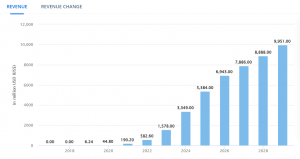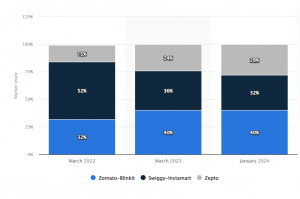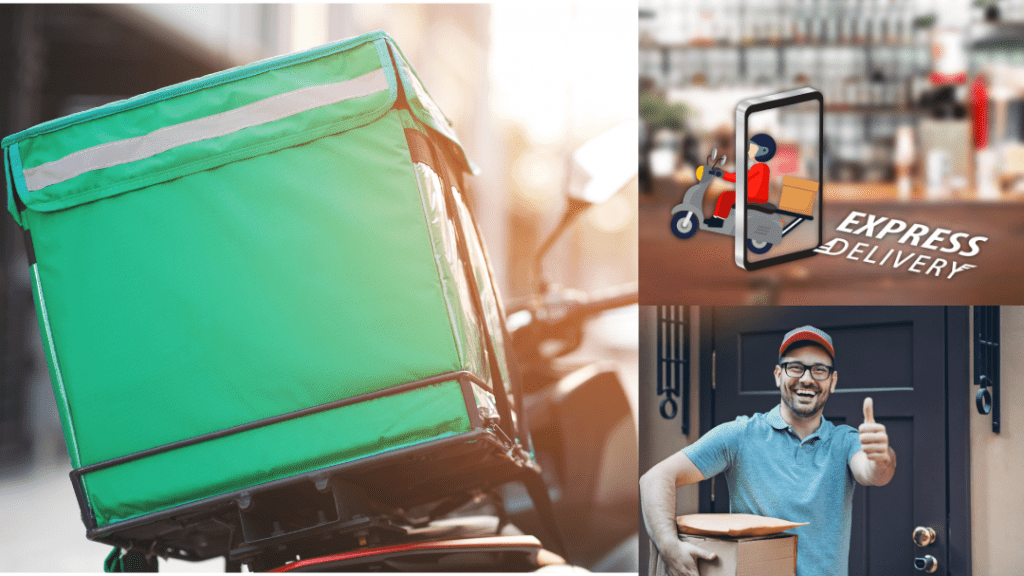Remember the days of shopping drudgery? Making lists, planning trips, and hoping you didn’t forget anything – only to realise you did and face another trek to the store. Forget that! Today’s all about instant gratification and impulse buying, thanks to quick commerce, or Q-commerce, a rapidly growing sector that promises delivery of essentials and impulse purchases within minutes.
This week on People Weekly we will explore the booming world of Q-commerce and how it’s changing the way we shop – and work, with a special focus on India. Through “The People Weekly”, it is the constant endeavour of PeopleLogic to bring to our valued readers the most up-to-date information on trending technologies and industry insights, equipping our readers with the knowledge they need to navigate the ever-evolving business world with a broader perspective and enhanced understanding.
Growth of Q-Commerce in India
The genesis of Q-commerce in India can be traced back to the early 2010s with the rise of online grocery delivery platforms like Grofers (now Blinkit) and BigBasket. However, the true turning point came with the emergence of dedicated Q-commerce players like Zepto, Dunzo, and Swiggy Genie in the late 2010s. These platforms capitalised on India’s growing smartphone user base and a surge in disposable incomes, particularly among young professionals in urban areas. Fueled by a convenience-driven culture and a desire to save time, Q-commerce adoption skyrocketed.
As per a recent report, Q-Commerce is increasingly becoming popular among Gen Zs and millennials and is now contributing to almost 80% e-commerce sales in FMCG companies. In fact Q-Commerce makes up about 5- 6% of household spend on groceries. Q – commerce industry in India is expected to grow at a CAGR of 24.33% and will lead to a projected market volume of US$9,951.00m by 2029. It is also projected that by 2029, India will have almost 60.6 million users of Q -commerce.

Some of the factors fuelling the growth of Q-commerce in India are
-
Post-Covid Scenario: The COVID-19 pandemic accelerated the adoption of online shopping, including Q-commerce. With lockdowns and social distancing measures, people turned to quick delivery services for essential goods, and the convenience stuck.
-
Smartphone Penetration: The exponential increase in the smartphone user base in India is also a major contributing factor to the growth of Q-commerce in India.
-
Growth of urban population: The urban population is growing owing to availability of jobs in cities and metros. This, coupled with busy lives and a growing demand for convenience have led to an increase in the use of q-commerce.
-
E-commerce & Technological advancements: The overall e-commerce market in India is flourishing, and advancements in technology are making it easier for businesses to offer quick delivery services.
Major Players in Q – commerce In India
In a report by Goldman Sachs, Blinkit, a major player in the Q-commerce industry is now valued at $13billion which is higher than Zomato’s main food delivery business. The Indian Q-commerce space is witnessing a fierce battle for market domination. Established food delivery giants like Swiggy and Zomato are leveraging their existing infrastructure and extensive delivery networks to enter the Q-commerce arena. These established players offer a distinct advantage – a captive user base already familiar with their platforms.
Meanwhile, dedicated Q-commerce startups like Blinkit and Zepto are attracting significant investments. Their laser focus on speed, strategic partnerships with local retailers, and innovative marketing strategies are propelling them to the forefront of the market. Additionally, global players like Amazon are also exploring entry into the Indian Q-commerce market, further intensifying the competition. Some of the major players in the Q-commerce sector in India include Swiggy-instamart, Zepto, Blinkit, Big Basket, Dunzo, etc.

The Q-commerce market is can be majorly divided into the following segments based on products
-
Groceries
-
Beverages and Snacks
-
Health & Hygiene
-
Beauty & Wellness
-
Stationery & Electronics
-
Homeware
-
Pet Care
-
Over the counter medicines
Consumer Behaviour A Catalyst for Q-Commerce Growth

The Q-commerce platform, which started with groceries and prepared meals, has expanded its offerings to include homeware, electronics, health and wellness products, and more. A recent report stated that the consumers are now ordering gold coins , air purifiers, fast tags and even iphones via Q-commerce platforms.
The Q-commerce boom is fueled by a changing consumer landscape. Not just younger generations, but also adults aged 35-50 are increasingly drawn to the convenience of rapid deliveries. This trend is evident in the continued popularity of services like Dunzo, which emerged as a lifeline during the pandemic and has now become ingrained in the routines of people across all age groups.
As for geographic locations, all major cities and metros are a strong market for Q-commerce. Even though cities like DehiNCR, Bangalore, Hyderabad, Chennai, Mumbai, Pune etc were always a market for Q -Commerce, places like Nagpur, Kochi, Jaipur, Vizag and Lucknow are also increasingly adopting the convenience of Q-Commerce facilities.
Experts point to a growing trend of consumers migrating from local kirana stores to Q-commerce platforms for grocery purchases. This shift might be driven, in part, by the potential for lower prices on Q-commerce platforms, with some items being 10-15% cheaper.
In fact Q-commerce now accounts for 50% of the online grocery market. And non grocery items account for 15-20% of quick commerce purchases. Millennials and Gen Z’s are majorly responsible for the Q-commerce growth.
Q-Commerce Revolution and Job Creation
The Q-commerce sector is growing at an exponential rate and is expected to reach $5 billion in 2025 from $0.3 billion. This growth will certainly catapult the Q-commerce industry as one of the largest employment generators in the country. The three dominant players in this domain, Blinkit, Swiggy Instamart and Zepto have employed over 2 lakh delivery partners and 50,000 operations personnel between them. Q-commerce relies heavily on technology for seamless operations. This creates demand for skilled professionals in areas like logistics management, data analytics, and app development. Dark stores – warehouses specifically for online orders require substantial workforce especially in areas like operations, and other support roles. In the coming days, the number of workforce in dark stores will only double. Q-commerce relies heavily on technology for seamless operations. This creates demand for skilled professionals in areas like logistics management, data analytics, and app development. Also, customer service is another area where Q-commerce will generate employment.
Challenges And The Road Ahead
This exponential growth of Q-commerce is not without its shares of challenges
-
Accurate demand forecasting( as close as possible to consumption) ensuring availability products is the key to success of a q- commerce platform and challenge. As opined by Zepto COO “Out of stock is unpardonable in the supply chain”.
-
Maintaining profitability with the high costs associated with rapid delivery and a dense network of dark stores (warehouses located within cities to facilitate speedy deliveries) remains a hurdle.
-
Started as 35- 40 minute delivery, Q-commerce is now a 10 minute delivery service. This is indeed challenging as the reliance on large delivery fleets can lead to traffic congestion and environmental concerns, not to mention safety concerns of the delivery personnel.
-
Ensuring fair labour practices and decent working conditions for delivery personnel is crucial for the sustainable growth of the sector.
-
As the Q-commerce market evolves, regulations need to be adapted to ensure responsible data management and fair competition.
Despite its challenges, the future of Q-commerce in India appears bright. There will be increased usage of AI influenced automation in order picking and warehouse management. Also, data analytics will be used heavily to predict consumer behaviour and preferences and recommendations as per the preferences. While still in its nascent stage, we can expect drone delivery of medicines and other essential items in the near future. Amazon, a pioneer in drone delivery, is in the process of expanding its drone delivery services in the US. In Gurugram, India, Skye Air Mobility has tied up with Flipkart, Bluedart and Licious for drone delivery of food, clothes, spectacles, and even gulab jamun.
PeopleLogic Opinion
Q-commerce is undeniably reshaping the retail landscape. Its explosive growth signifies a fundamental shift in consumer behaviour – a demand for immediate gratification. While challenges like infrastructure and regulations remain, continuous innovation and collaboration between businesses and governments can pave the way for a future where Q-commerce becomes seamlessly integrated into our daily lives. As technology advances and infrastructure adapts, Q-commerce has the potential to revolutionise not just how we shop, but also how cities function and communities thrive.
In the fast-paced world of Q-commerce, success hinges on recruiting a highly skilled and adaptable workforce. With our expertise in recruitment, both tech hiring and non tech hiring and deep understanding of the industry, we can be a valuable partner in this endeavour. Our team can identify candidates who possess the necessary blend of tech-savviness, operational efficiency, and customer-centricity that thrives in the Q-commerce environment. Our targeted sourcing methods and robust assessment processes which has catapulted us as one of the top recruitment agencies, can ensure you find individuals who can adapt quickly, embrace innovation, and contribute to the breakneck growth of your Q-commerce business.






